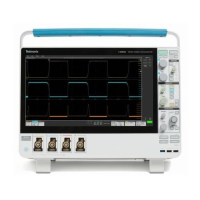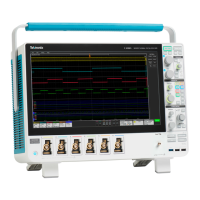Commands listed in alphabetical order
Syntax
SOCKETServer:
PORT <NR1>
SOCKETServer:PORT?
Arguments
<NR1> is the TCP
IP port for the socket server connection.
If the socket server is enabled and the port specified is in use by another service,
then the error
event code 221 (Settings conflict) is posted to the event queue
and the socket server remains in its current state (i.e. enabled/disabled and port
address remain unchanged).
Similarly, if any sessions are active when the port is changed, this same error event
may be posted to the event queue and the port will remain unchanged. In this case,
exit all current sessions and send the :SOCKETServer:PORT command again.
Examples
SOCKETSERVER:PORT 4000 sets the socket server port number to 4000.
SOCKETSERVER:PORT? might return :SOC KETSERVER:PORT 4000 indicating
that the port number is 4000.
SOCKETSe
rver:PROTOCol
This command sets or queries the protocol for the socket server.
Group
Miscellaneous
Syntax
SOCKETServer:PROTOCol {TERMinal|NON e}
SOCKETServer:PROTOCol?
Arguments
TERMinal specifies terminal protocol for the socket server. When set to
TERMinal, a session startup message is sent to the socket and a command prompt
is provided.
NONe disables the terminal features, allowing the server to be used for raw socket
transactions, such as wit
h a VISA socket server. The default setting is NONe.
Examples
SOCKETSERVER:PROTOCOL NONE sets the protocol to none.
SOCKETSERVER:PROTOCOL? might return :SOCKETSERVER:P ROTOCOL
TERMINAL
indicating the protocol is set to terminal.
MSO54, MSO56, MSO58, MSO58LP Programmer 2-753
